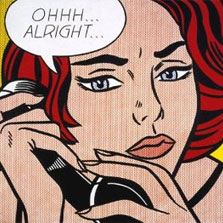| Pop Art History > Independent Group | ||||
|
Independent GroupThe Independent Group was a coalition of artists of various media�sculptors, painters, architects, and even writers and musicians to some extent�who emerged out of London's art scene in the early to mid 1950's.They had a strong influence over the pop art movement, and in fact some of the first true examples of British pop art were produced by members of this group. Influenced by the modern cultural artifacts that surrounded them�and American mass media in particular�such as movies, magazines, comic books, science fiction, advertisements, and the like, they gave birth to the modern pop art movement that would eventually become a major genre of art. Their influence was strong enough to shape the course of this artistic movement and to even spread it into the United States over time. Due to a number of their early exhibitions, the definition of the movement was formed, and many artists joined the fold, creating collages, paintings, and sculptures that were influenced by the popular culture of the age. �Some of the key members of the Independent group were Eduardo Paolozzi (a visual artist of several media), Richard Hamilton (another artist), William Turnbull (a sculptor), Nigel Henderson (a photographer), and Lawrence Alloway (an art critic). They met and discussed art at the Institute of Contemporary Arts in London, where together they produced some of the first examples of pop art and ran some of the first exhibitions to heavily incorporate pop art pieces. Many of the collages and paintings created by the group's members at this time would go on to become classics of the pop art movement. The Independent Group was founded in 1952 in London and lasted until roughly 1955. Much proto-pop and pop art that focused on the idea of �found art� was produced by members of the group until its disintegration, and afterward several members would go on to become popular artists in their own right, some even relocating to the U.S. and collaborating with American pop artists such as Andy Warhol. �One of their most important group exhibitions was Parallel of Life and Art, which they staged in 1953, and which included the work of Ronald Jenkins, Eduardo Paolozzi, and Richard Hamilton among many others. �The exhibition Collages and Objects, which was curated by art critic Lawrence Alloway, was organized in 1954. A later exhibition Man, Machine and Motion was set up by Richard Hamilton in Newcastle in 1955. The Independent Group did not receive much mainstream attention until many of their members were featured in the popular exhibition This Is Tomorrow in 1956. Though the group technically disintegrated in 1955 and no formal meetings were held after that point, members of the group continued to meet and collaborate well into the early 1960's. Some of the members also continued to work together in the decades that followed, contributing to the pop art movement within less formal social groups. �All in all, The Independent Group is considered, to this day, to be a foundational force in the world of pop art.

|
|||||||||
| Pop Art History | What is Pop Art? | Origins of Pop Art | American Pop Art | British Pop Art | | Artworks Top 10 Famous Artworks | Roy Lichtenstein | Richard Hamilton | Andy Warhol | Timeline | Dictionary | FAQ | Citations | References | Websites Pop Art History - All artworks copyright belong to the artist - Reproduction is strictly prohibited |

